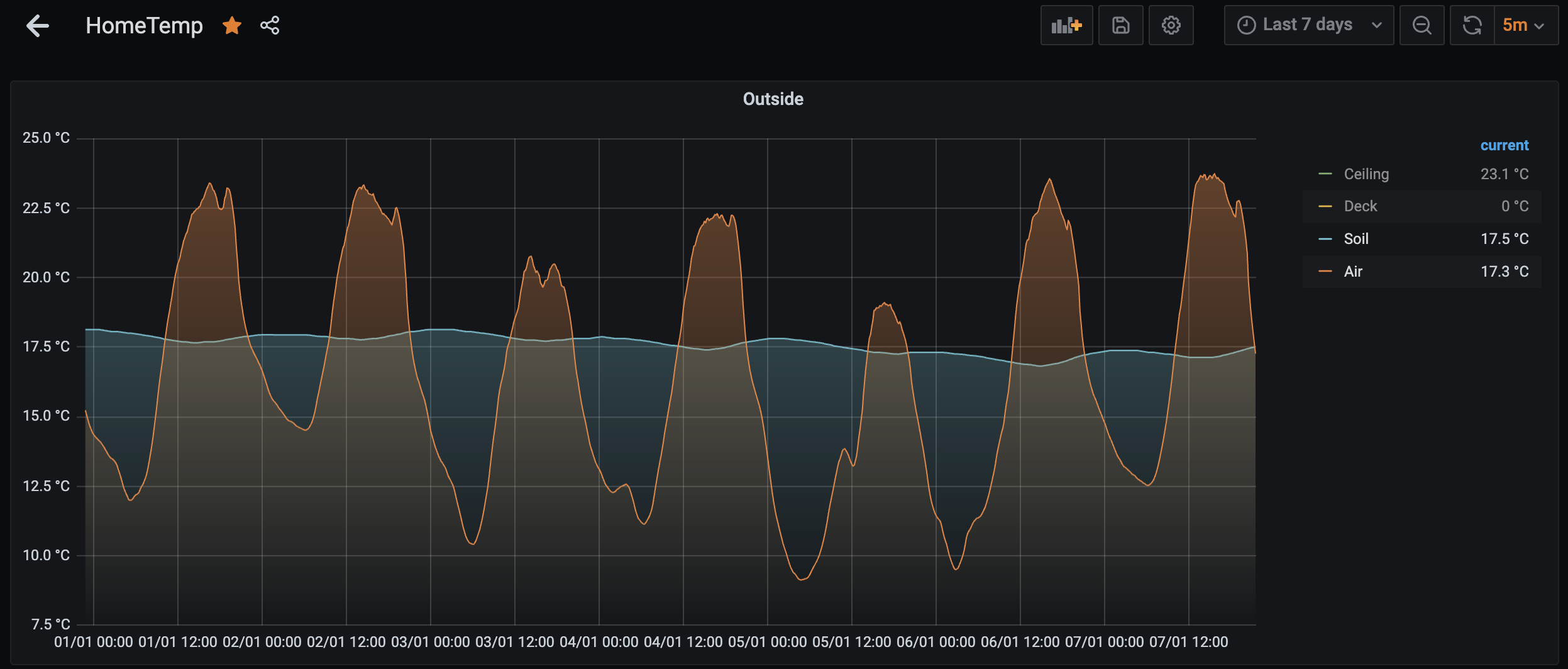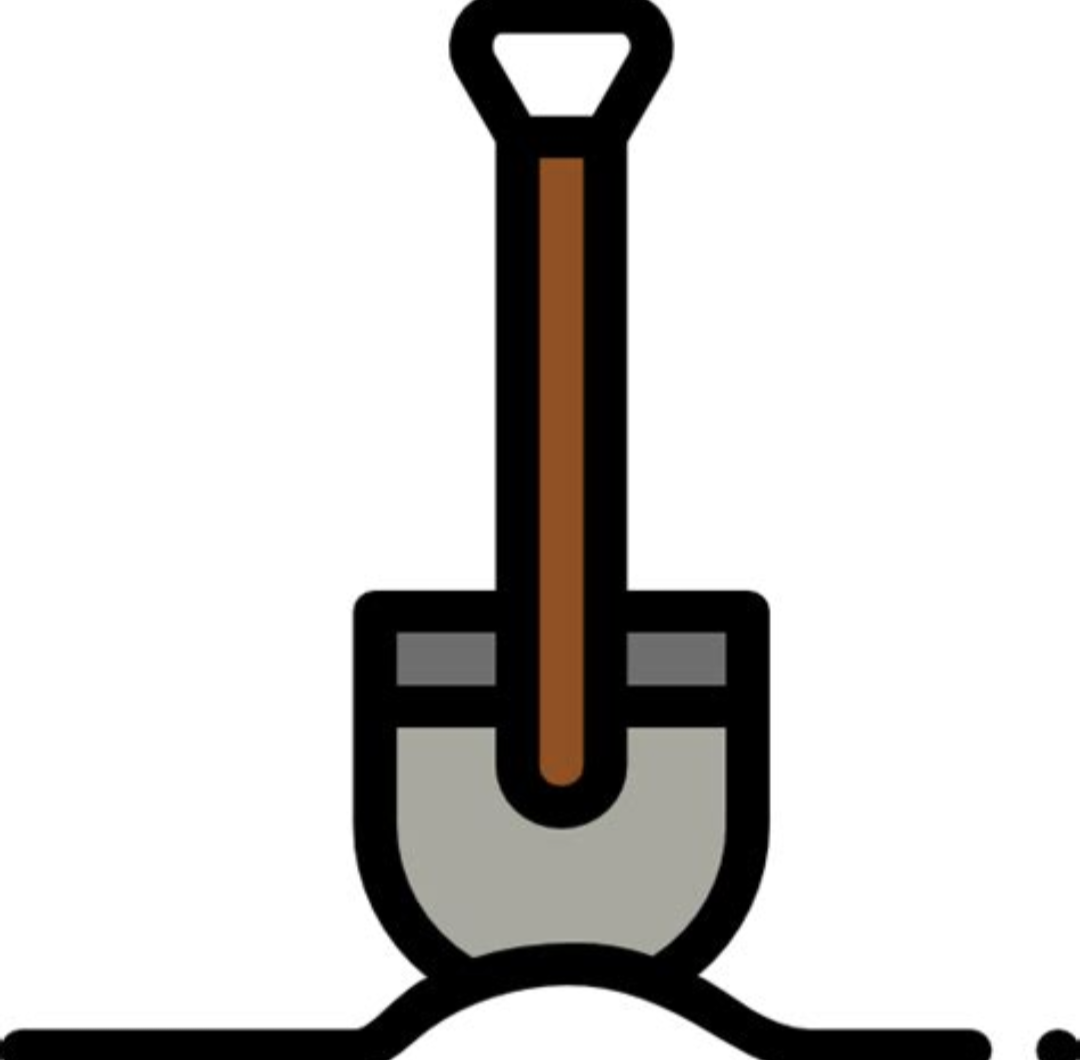I’ve been using HA for a while; having my home just “do things” for me without asking is fantastic. My lights turn on to exactly the levels I want when I enter a room, my grass and my plants get watered automatically, heating and cooling happens only when it needs to. There are lots of benefits. Plus, it’s just a fun hobby.
One thing I didn’t expect, though, is all the interesting things you can learn when you have sensors monitoring different aspects of you home or the environment.
- I can always tell when someone is playing games or streaming video (provided they’re transcoding the video) from one of my servers. There’s a very significant spike in temperature in my server room, not to mention the increased power draw.
- I have mmWave sensors in an out-building that randomly trigger at night, even though there’s nobody there. Mice, maybe?
- Outdoor temperatures always go up when it’s raining. It’s always felt this way, but now it’s confirmed.
- My electrical system always drops in voltage around 8AM. Power usage in my house remains constant, so maybe more demand on the grid when people are getting ready for work?
- I have a few different animals that like to visit my property. They set off my motion sensors, and my cameras catch them on video. Sometimes I give them names.
- A single person is enough to raise the temperature in an enclosed room. Spikes in temperature and humidity correspond with motion sensors being triggered.
- Watering a lawn takes a lot more water than you might expect. I didn’t realize just how much until I saw exactly how many gallons I was using. Fortunately, I irrigate with stored rain water, but it would make me think twice about wasting city water to maintain a lawn.
- Traditional tank-style water heaters waste a lot of heat. My utility closet with my water heater is always several degrees hotter than the surrounding space.
What have you discovered as a result of your home automation? While the things I mentioned might not be particular useful, they’re definitely interesting, at least to me.
I can see if someone is on the toilet and having a Nr.2 by checking the power draw of the Japanese style toilet. (I also have a presence detector). I do not monitor the first part intentionally, though.
I unintentionally catched some birds eating on camera and that led to us installing a designated bird cam - in a 3D printed bird house. The AI model for identification is still in the works though - there aren’t any good European based ones available as open source so I still will need to work out my own.
I found out the kid is reading FAR more than thought and is using the PC far less than I thought. Sorry kiddo!
CO2 is going up far more than expected,yes. What I found more interesting, though, is the direct connection between the humidity and my sinus infections - I always get them if my room air gets to dry.
Cooking releases an ungodly amount of VOC and uses FAR more electric energy than I thought.
And: After two years of optimisation I can control the temperature in two very sun exposed rooms just by using the covers and a weather forecast extremely well. Means they are up to 4° colder in the summer than before and 10° warmer in winter. Sadly this does not apply to all rooms.
And last but not least: Heating is the only point where home automation really saves energy here.
I had a terrible run of sinus infections last year so I’ve been using a humidifier and been checking the humidity in the house daily this winter. What percent range do you find is ideal?
I try not to go below 47%
Did you try BirdNET Pi?
Was going to suggest this - I’ve not used it myself but friends have and the model apparently does have fairly good results https://github.com/kahst/BirdNET-Analyzer
You know what, I’ve just checked and birdNET app is the one I use in the field, I thought I was using something from eBird. BirdNET is great for UK birds, I use it all the time! I’m an ecologist doing bird-stuff
Do you have induction hobs or traditional electric?
Induction
Huh, I figured induction would be cheaper.
My office electric space heater, on low, uses more energy than our pellet stove.
My server (and network gear) also use slightly more energy than the pellet stove.
The pellet stove’s energy usage does not seem to be drastically affected by the setting it’s on - this winter I’ve been keeping it on setting 2 (of 5), but the other day I ran it at 4 for a few hours. No distinguishable change in electricity usage during that time.
Wait, doesn’t a pellet stove produce heat by burning pellets? I’d figure the electricity use would be similar to a gas furnace, where it’s just running sensors and cycling it on or off.
Don’t you have to buy pellets and maybe even load them into the stove, depending on what kind of delivery system/hopper your stove uses?
Yes to all of that, except for the comparison to the gas furnace: I don’t know how much electricity they use (I know some, because our previous house had one, but it’s not a ton - electronics, igniter, and blower fan).
Yes, I do have to buy pellets and load them into the stove; I like to say the stove warms me up multiple times: Loading the pellets into our pickup, unloading them and stacking them in the garage, moving the bags from the garage to the stove (okay, this is not that hard and doesn’t warm me very much), and then when the pellets finally get burned. They’re 40 lb bags, not terrible but some work to move. (On reddit, at this point, I’m sure someone would jump in and call me a wimp or whatever, but having stacked a ton of them alone multiple times, it definitely adds up.)
The stove has two motors in it, I believe: an auger to lift the pellets from the hopper and drop them into the burn pot, and a blower fan for the draft for the fire. There may be a third fan to circulate warm air across the heat exchanger tubes as well, but I don’t remember for certain. There’s also an electronic board to control on/off, heat level, when to run the auger, etc.
My comment above was noticing that the power it consumes isn’t very different on different levels - which isn’t surprising, the fan runs a bit faster and the auger has to turn a bit more often, but it wasn’t an obvious difference over a few hours. I have it on a power monitoring plug to detect if it’s running (for automations like turning on a ceiling fan to help circulate the warm air, and keeping track of run time so I know when I need to clean it). I’ll have to test different levels to see if I can find a way to detect which level it’s set on.
Ah I see what you mean, my mind interpreted what you were implying in a completely different direction from what you intended.
Which makes me realize I had missed on a big part of home automation by not realizing you don’t need to have direct communication with the appliances for an automated home.
I need to look in to smart water flow meters and maybe I’ll be able to implement one thing that’s been kinda a pain here: needing to manually check the water softener level to tell if I should cycle it before running the dishwasher or washing machine. I also need to move things to get into the utility closet, so it’s a pain. Instead I could measure the flow to know how much is left and reset it when the softener draws more power for its regen cycle. And then have something check it and send an alert any time either of those water using appliances draw more power than idle if soft water available is less than a threshold.
Also, for your problem, I’m assuming now that the intention is to turn up the ceiling fan if the stove is at a higher level? Or something to do with circulating air based on that? If so, what about using temperature sensors and the difference between them? I think that would end up being more efficient and effective than just going by the stove setting, since you don’t need high fan as the stove warms up and might still want the fan going after it shuts down.
Or if you want to know for some other reason (pellet use tracking?), you could combine temperate differential with current fan settings and calculate a rough estimate of how much thermal energy it’s putting out.
The fan just turns on low when the pellet stove is running, nothing so fancy as changing the speeds based on the stove setting. But that could be accomplished indirectly by just looking at the temperature in the area - if it’s a few degrees higher than, say, the living room, turn up the fan speed.
In an ideal world I’d be able to control the setting on the stove remotely - there’s a button to change the setting, which a switchbot could theoretically do. Of course to do that reliably, HA should know what the current setting is. I haven’t really looked into this much.
But, yeah, I do wish I had a way to track the pellet level to alert me when it’s getting low. I have a Salt Sentry to monitor the salt in the water softener, with a gauge in HA, and it warns me when it’s getting low. Which is great (when it works, sometimes it stops responding). I’m not sure if it would work as well for the pellets - the pellets would be right up against the sensor when it’s full. Another option might be a weight sensor under a leg - I have no idea if this is even feasible, but if is, it should be able to detect the 40 lbs change (noting that there’s some ash left in the stove, so the 40 lbs doesn’t completely disappear).
I use the power monitoring plug for a lamp in the living room that is dumb, but it has a 433 mhz remote. The power monitoring detects whether it is on or not. I have one of those Sonoff 433 mhz transmitters, so with the power monitoring plug I can control the light. This also means it can be part of my “vacation” mode where it perhaps turns on at some point in the evening, then turns back off. Also, it turns on when first connected to power, so I can do an automation that sends the “off” command at night if the house is in Vacation mode and the light is on.
I don’t really have it set up yet, but in theory the power monitoring plugs could warn me if the freezer stops working (or is running constantly), the sump pump stops working, etc. I have the power monitoring in place, but not the automations to detect issues.
OP’s post is a good lesson in the value of metadata and how important data privacy protections are.
The humidity in my apartment is affected far more by cooking than by showering.
Is it the food or just that your extractor fan is bringing in outside air? (Please tell me you cook with an extractor fan!)
I don’t have a fan, but I have a window near my stove. HA’s graphs let me compare the effect of opening the kitchen window by itself vs opening it while cooking, so I can isolate the effects.
Are you cooking on gas?
You might recall that carbohydrates being burned release a lot of H2O.
IME, the humidity from cooking is much much less when using an induction stove
No, induction.
I haven’t tried to differentiate between cooking involving boiling, steaming, etc. versus sautéing, frying, or other oil-based methods—I assumed the humidity spike was due to the former.
Hydrocarbons. Carbohydrates are in bread, pasta and potatoes.
Oven full of carbohydrates = good
Oven full of hydrocarbons = bad
Many many places (it is a trend now) just have extractor fans that simply run through a shitty filter and blow it back into the room. My old rented house (it was just renovated in 2021) was like that along with tons of moisture problems coming from a half-assed renovation (turns out, the church officials were embezzeling a ton of money from the church company that came out a few years later) of a protected monument house from the 1500s.
Some apartments can have a charcoal filter hood instead of a fan that extracts directly to the outside, depending on ventilation design. My fan is one of those.
Most recently I discovered my house naturally has one of those “the sun will shine exactly here at one time of the year” things going on, like a treasure hunting movie trope. A reflective mosaic on hung my neighbor’s shed is in the right spot that, in late December, sun reflection causes a arc of sunshine to slowly sweep over and brighten up spots on my back porch for an hour or so.
I recently made an ESPHome based weather station that includes a LUX sensor. I was updating a lighting automation so it would turn on sooner during dark mornings using the new sensor and I noticed a daily spike in light. The neighbor put up that mosaic several years ago and it took a HA histogram for me to notice.
Awesome. On a similar note, there is a time of the day at a certain part of the year when our TV seems to receive random remote control button pushes. I know it’s solar infrared but hadn’t considered it may be a reflection instead of direct radiation.
Did you use any established project for your weather station or just make it up for yourself? I’ve been interested in building an esphome weather station as well.
I, too, have such an interest. One thing I ran across about two months ago that I thought was neat was a project for a DIY wind gauge with no moving parts.
My old Samsung printer can enter a state where it consumes ~100W without doing anything meaningful. It’s not obvious what is wrong, but without power monitoring I would have never realized this.
CO2 levels raise astonishingly fast when people are present in a room.
I have mice visiting my garage and I can tell when by looking at the motion sensor history.
My uninsulated roof stays frost free even at -15°C.
What type of printer? Maybe keeping the ink from going solid?
Probably a laser printer, keeping warm to be ready to print as soon as it gets a job. My laser printer (also Samsung) draws nearly 1000w after a cold start.
If turned off after use, as in powered off, the laser printer first must go through a warm up cycle where it needs to heat up the fuser so it can “bake” or fuse the text/image to the printed page. This is where you see a tremendous power spike, and can often overload a battery backup if you have it connected with a computer as well.
Maybe it’s keeping the roof frost free too…
My old furnace was hilariously oversized for the house.
One of the nifty things about smart thermostats like Ecobees is that you can pull usage data from their web portal. I grabbed a CSV file covering a cold snap last year that reached a 100-year record low, and using Excel I summed up the total heat output while we were at that low.
The furnace was only running 50% of the time, even when it was with a couple degrees of as cold as it’s ever been where I live.
Needless to say, when I got a new system installed I made sure it was more properly sized, and given that I had a convenient empirical measurement of exactly how many btus I actually needed in the worst case as scenario, that was easily done.
Having an oversized furnace really isn’t a bad thing, and only having it run half the time sounds like a good thing to me.
A little headroom ain’t bad, but it had three times the required heating capacity for my area’s “design day” low, which meant that for most of the winter it was kicking on for maybe 5-10 minutes per hour and then leaving massive cold spots in the house, because the thermostat was smack in the middle and all the walls were bleeding heat.
My new heat pump is just about 2x the design day heat requirement, but that also means it’s got capacity to handle extreme lows without resorting to resistance heat, and in any case it’s fully modulating so the house has stayed quite comfortable so far.
It wears out the furnace doing short butts and the house doesn’t get heated evenly. I had the original furnace from 1968. When I upgraded everything with insolation and better windows, I went from a 80,000 BTU on/off furnace to a 40,000 but modular furnace. No more sweating after 10min and then cold. Just evenly bring up the temp over a longer time. https://youtu.be/DTsQjiPlksA
That technology connections video is great. It’s crazy how oversized heating systems are, especially when it costs us so much money.
That was in a worst case scenario though. I’d expect my furnace to reach closer to 80% duty cycle in a once in a lifetime cold front.
It’s better to have it max out in a 100 year cold snap, as they don’t happen too often, and it’s ok to drop a few degrees when that happens. Much more important to save money on your heat pump investment than spend thousands worrying about weather that never happens.
Technology Connections video about this problem:
I thought working 100% for hours on end wasn’t recommended for a residential unit. Love me a Technology Connections episode, thanks!
yeah, I could be wrong, but that was the takeaway I got from the video, yeah. I have district heating so I don’t have first hand experience.
Even 100% on the coldest day is not per se an issue provided additional heat can be used. Space heaters, gas fire places, and baking being big ones.
Well, if cheating is allowed…
Evcept you spend more on it for no reason
One of the nifty things about smart thermostats like Ecobees is that you can pull usage data from their web portal.
Ecobee also let’s you connect over HomeKit and allows you to control when the internet is out 😉at my old house I actually blocked the mac address for non internal and just had HA automatons take care of the rest.
I actually blocked the mac address for non internal and just had HA automatons take care of the rest.
Can you explain this? Not sure why but I cannot parse that sentence. You blocked external Mac addresses?
Not OP, but I believe he means he restricted outside internet access to that device (restricted communications to the thermostats MAC address to other internal devices)
I tend to post then disappear lol but what the other person said: at the router level, I added a rule specifically to block a given list of MAC addresses. That included IP cams & the ecobee, then had HA act on data from other sources to adjust temperature.
The one I was proud of was 433mhz door and window sensors that, if opened for too long, would turn off the heat / air and just leave a fan on.
Not sure if you got this idea from Technology Connections but he recently didn a video using this exact premise.
I checked HA and found that A) my furnace fan is likely dying as the furnace overheats and power cycles frequently and B) despite the overheating, or furnace has only run at most 25% of the day during the coldest temps we’ve gotten this winter (which has been mild and only down into the low 30s). I think if/when we replace the furnace we can safely cut the BTU rating down while still maintaining our desired temperature.
A friend in HVAC told me each person produces 350 btu of heat on average
Yes, but that is a person at rest. They generate more heat if they are active. Useful if you’re planning the heating needs for movie theater as compared to an exercise studio.
I have a Dyson smart air purifier / heater combo in my room. It has a mostly real time app that shows whether the air is healthy or unhealthy. One night I was laying in bed and felt some gargantuan ass thunder brewing, so I aimed my cheeks toward the Dyson and watched gleefully as my air quality went from green to red. Technology is amazing.
Tell me more about automatically watering plants
I have a Rachio irrigation controller. I’d recommend OpenSprinkler to avoid being tied to a “cloud” service, but I didn’t know that when I purchased my Rachio.
One of my irrigation zones feeds into my greenhouse. It splits off to two solenoid valves. When it’s time to water my plants, HA triggers that zone through the Rachio integration and opens the appropriate solenoid valve that connects to my emitters. If my humidifier gets low, then it does the same thing but opens the other valve.
I’ve caught the front door and garage door left open several times (kids)
I found out my garage under my bedroom is primarily why my room is hard to heat and likely has poor insulation in the ceiling.
I found out my Samsung TV was sending a LOT of data home.
I know every time my Roomba gets stuck so I can go and locate it before the battery dies.
I know when my unraid Dockers fail to update and accidentally delete the old containers, so that I can go and re-add them.
One of my children were doing remote learning and I would get an alarm if he didn’t get up in the morning and start using his Chromebook.
Do you have some sort of notification for the docker fail one? I’m currently just periodically visiting the previous apps page in the Apps tab, but that’s annoying and manual.
How much data is a lot? Mine lost wifi privileges for putting ads in my stuff, but I’m still curious.
It was burning a few gigs a day. Which wouldn’t have been noticed except I wasn’t using it to stream anything. I originally put it on the time out vlan, But my wife wanted to make changes to art mode, and of course that requires cloud connection. I should probably go back and isolate what it talks to and see if I can get art mode to continue working without letting it do whatever high bandwidth application it was trying to do before.
That’s nuts, good luck with the sluething
Outdoor temperatures always go up when it’s raining.
Are you saying the outside weather temperature rises when it starts to rain, or am I understanding that incorrectly?
It’s probably rain clouds trapping heat from escaping into the atmosphere, and humid air equalizing the temp by sucking heat off of high heat capacity surfaces like rocks and cement, warming the air.
That’s just my guess though. I have no relevant scientific expertise.
Along a similar line, ground temp (~200mm deep) lags air temps by about 12 hours

Depending on the location, but
- Often rain comes along for the ride on a warm front as it moves over the property (although cold fronts also carry rain)
- In winter, the rainclouds act as insulation and so rainy days are warmer than blue-sky days
I learned my air filter uses almost no electricity so I just leave it running 24/7 now.
I never thought about temperature/humidity sensors! I know some gardeners that use them in various greenhouses, but that’s interesting stuff. Is there anything yall’ve learned about the power efficiency of heating/cooling methods? Currently we’re making a lot of baked goods and stews to keep the house warmer and more humid, but I don’t have any data on actual power use changes.
I’ve had a temp/humidity temperature in all house rooms for a few years now, and it’s dead useful.
Balancing the radiators and TRVs so everything heats up evenly.
Spotting anomalies (top floor loses a lot more heat when the wind is blowing)
And setting the flow temperatures for the radiators, as I can see the rate of heating compared to outside temperatures.
By recording the electricity use in my house I noticed a 1500 watt spike at a semi-regular interval. It would happen every 50 minutes and lasted for a few minutes. While overall not that much of a draw, it sort of drove me crazy not knowing what it was…
Then I discovered that it was our septic system’s effluent pump (the leach field is up on a hill). The pump was turning on way too often because ground water was leaking into the pump chamber. It’s not supposed to do that. The tank was about 45 years old, so not a huge surprise really.
Basically, my home automation (or tracking, really) lead to an $8k concrete tank replacement (more or less, as we had the guy do some additional stuff while he was here).
That’s not really a bad thing though. Maintaining your house is very important. Our well had failed a coliform test the previous year, and I’ve yet to get it re-tested to see if the new tank fixed that little problem. I’ve been giving everything some time to settle down.


















